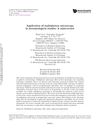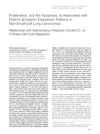Search
forLearn
3 / 3 resultslearn Osteopontin
signaling protein that, when suppressed, may grow hair by reducing inflammation and stem cell loss
learn Bicalutamide
a nonsteroidal anti-androgen, most commonly used orally for women
Research
5 / 1000+ resultsresearch Ectopic Olfactory Receptors in Humans: New Therapeutic Possibilities
Olfactory receptors found outside the nose may offer new treatments for diseases like cancer and help in wound healing and hair growth.
research Transglutaminase-3, an Esophageal Cancer-Related Gene
Transglutaminase-3 is often reduced in esophageal cancer.

research Application of Multiphoton Microscopy in Dermatological Studies: A Mini-Review
Multiphoton microscopy is a promising tool for detailed skin imaging and could improve patient care if its challenges are addressed.

research Heavy Metals in Biological Samples of Cancer Patients: A Systematic Literature Review
Heavy metals like arsenic, cadmium, and lead can increase cancer risk and worsen outcomes.

research Proliferation, But Not Apoptosis, Is Associated With Distinct Beta-Catenin Expression Patterns in Non-Small-Cell Lung Carcinomas
Distinct β-catenin patterns are linked to cell growth, not cell death, in lung cancer.
Community Join
5 / 106 resultscommunity The Real Cause Of Androgenetic Alopecia
Androgenetic alopecia is caused by DHT affecting hair growth. Finasteride and minoxidil are used to manage hair loss by blocking DHT and promoting hair growth.
community Dermatologist told me to quit fin after turning 40
A dermatologist advised a patient to stop taking finasteride (fin) after turning 40 due to potential risk of aggressive prostate cancer. The patient and others in the conversation debated this advice, discussing the relationship between finasteride, prostate cancer, and hair loss, and considering alternatives like topical finasteride.
community Are Derma Rollers Actually Harmful in the Long Run?
Derma rollers may cause scarring alopecia, leading some to prefer dermastamps or dermapens for microneedling. Combining minoxidil with microneedling is effective, but proper technique and healing time are essential to prevent damage.
community Fluridil downregulates androgen receptor expression?
Fluridil may decrease the number of androgen receptors in hair follicles by up to 95%. This suggests a different action mechanism from other non-steroidal antiandrogens like RU58841, indicating they might be used together.
community How promising is th RCH-01/Replicel treatment? Is there any new info that suggests it will be as successful as it claims? What other promising treatments are close?
The conversation is about the potential of the RCH-01/Replicel hair loss treatment and its lack of updates since 2013, with the user expressing hope for its success and considering using Minoxidil, finasteride, and dermarolling in the meantime. Other treatments mentioned as promising are Breezula and Tsuji.